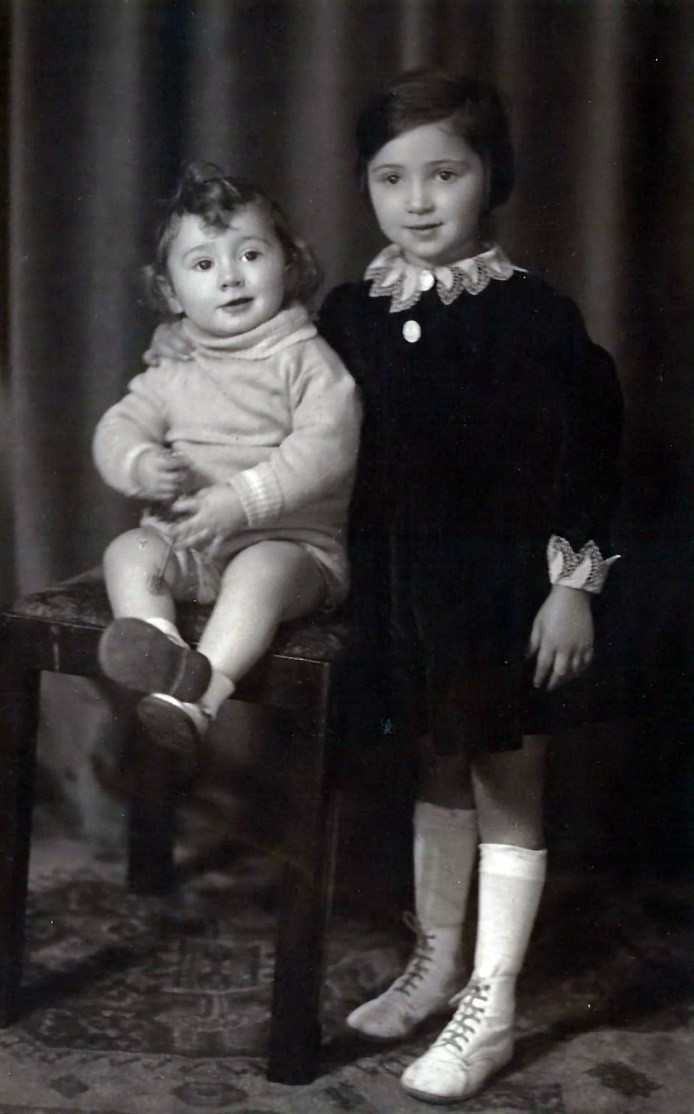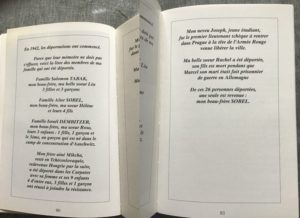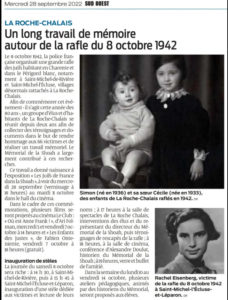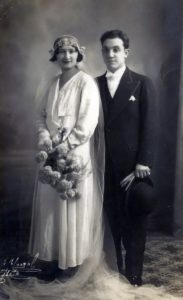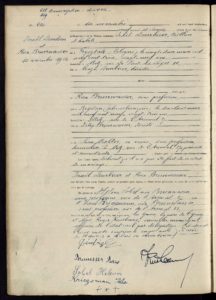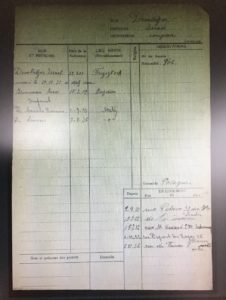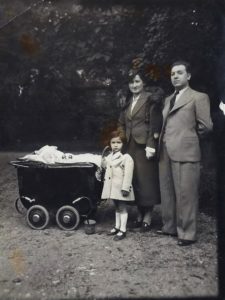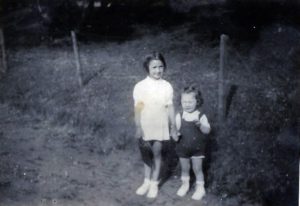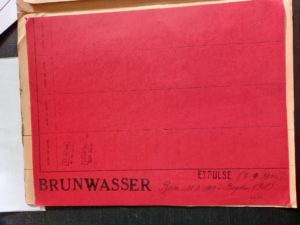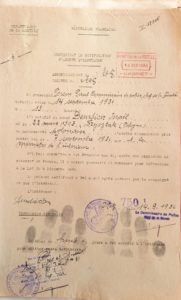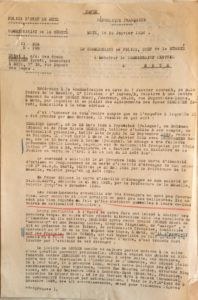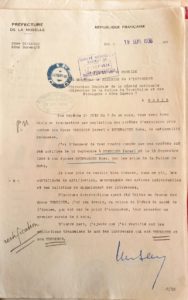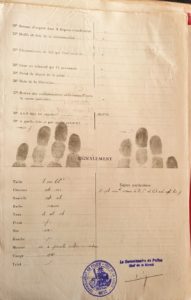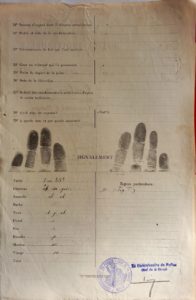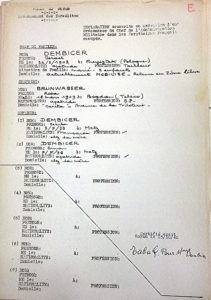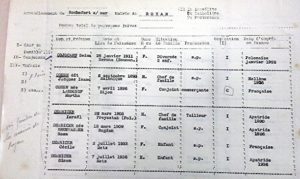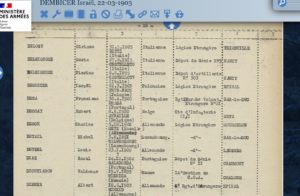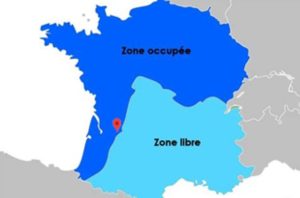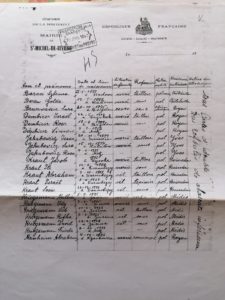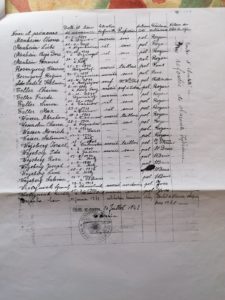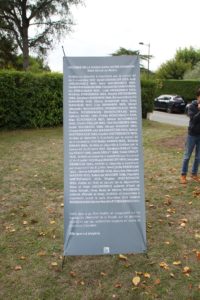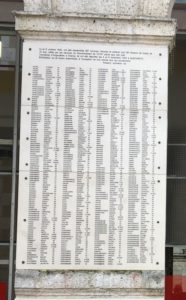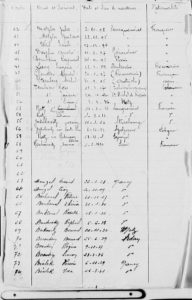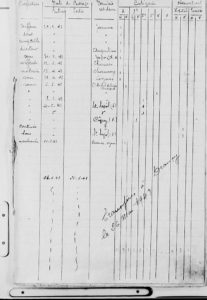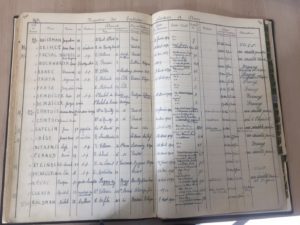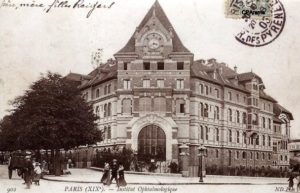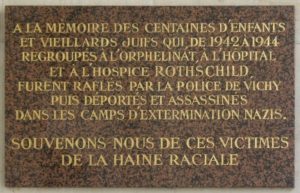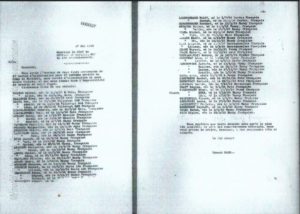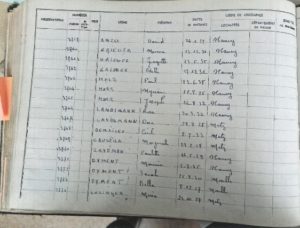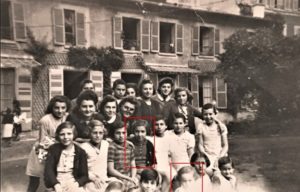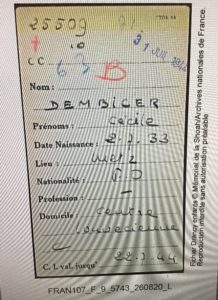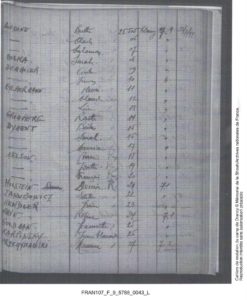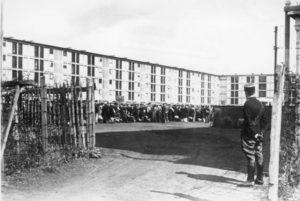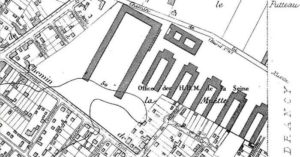Cécile DEMBICER
Photo of Cécile Dembicer with her brother Simon around 1938 (Family archives)
The beginning of our investigation
During World War II, 6 million Jews died, out of the 11 million who were living in Europe in 1939. Among them were all of the Dembicer family, who prior to 1939 were living in Metz, in the Moselle department of France.
We are a class of 35 10th grade students from the Louis Vincent high school in Metz. This is why we were interested in this family, which also came from Metz. Thanks to the help of Julia Ghisalberti, a second cousin of Cécile and Simon Dembicer, we were lucky enough to gather a number of documents and other information. She carried out extensive research and introduced us to her grandfather Boumi Brunwasser’s book, Sur le chemin de ma vie, (On my life’s journey) in which he writes about the 26 members of his family who died during the Holocaust.
The First and fourth cover pages of the book Sur le chemin de ma vie, by Boumi Brunwasser.
(Family Archives)
Pages 80 and 81 of the book Sur le chemin de ma vie, by Boumi Brunwasser.
(Family archives)
We also had the opportunity to work in partnership with students from the Jeanne d’Arc junior high school in la Roche-Chalais, in the Dordogne department.
Joint investigation with students from Metz-Saint Michel de Rivière (junior high and high school)
Photo of the class of 9th grade students at the Jeanne d’Arc junior high school in La Roche-Chalais with their history teacher, Mr. Abdelli.
(2022-2023 school year)
Article in the Sud-Ouest newspaper published on September 28, 2022 to mark the inauguration of a memorial to the victims of the roundup at La Roche-Chalais on October 8, 1942.
In September 2022, when we found out that there was going to be a memorial Day at Saint-Michel de Rivière on October 8, we began working in partnership with some junior high school students from La Roche-Chalais. La Roche-Chalais now includes several former municipalities, including Saint-Michel de Rivière, where the Dembicer family lived during the war. Together with our fellow students, we held several video conferences. They carried out a survey of local residents to gather information about the Dembicer family and other Jewish families who had taken refuge there during the war. They were actively involved in the ceremony held on October 8, 2022 to commemorate the 80th anniversary of the roundup at the Philharmonic Hall in Angoulême, during which some memorial stones were unveiled. Among the 200 or so people who attended the event were not only some Holocaust survivors, but also Julia Ghisalberti and several members of her family. This partnership proved extremely helpful to us.
The ceremony in Saint-Michel de Rivière on October 8 began at 2.30pm with the unveiling of the memorial, which was followed by speeches by elected representatives, reading out the names of the victims, a minute’s silence and laying flowers. Lectures by historians, speeches by family members and schoolchildren rounded off the day’s events.
We are extremely grateful to our fellow members for their cooperation, during which we shared news of our findings. Thanks to them, to Julia and to documents we collected from various archives services, we have been able to piece together the broad outlines of Cécile’s life story.
The family’s time in Metz
Cécile Dembicer was born on July 2, 1933 at the Belle-Isle hospital in Metz. She was the eldest child in the family. Her parents, both of whom had migrated to France, were Rose and Israël Dembicer, who got married in Metz on November 10, 1932.
Rose Brunwasser, Cécile’s mother, was born in Bogdan, Czechoslovakia, on March 18, 1909. She migrated to France in 1926 together with her parents and eight siblings. The whole family lived at 37 rue de l’Arsenal, in the Jewish quarter of Metz, near the synagogue. Her father, Zelig, who was a cobbler, died in 1931. According to the records, Rose was either a seamstress or did not work outside the home. On her marriage certificate, she signed her name awkwardly and spelled it “Brunsser”, which suggests that she had difficulty writing. Two of her sisters, Hélène and Ida, were her witnesses.
Rose and Israël Dembicer’s wedding photo.
(Family archives)
Rose and Israël Dembicer’s marriage certificate, issued on November 19, 1932.
(Metz municipal archives)
Israël Dembicer was born on March 22, 1903 in Freystak, Poland, and worked as a tailor. According to his address card, he migrated to Metz on September 2, 1930. When he arrived, he was single. He initially stayed with a widow at 33 rue Pétain, where he probably rented a room. In July 1932, shortly before he married Rose, he moved to 32 rue Saint Médard, and then in November to 18 rue Dupont des Loges. Finally, on December 1, 1936, after their second child Simon was born (on July 7, 1936), the family moved to 8 rue du Faisan, probably because they needed more space.
Israël and Rose kept their original nationalities. Cécile, on the other hand, was declared a French citizen shortly after she was born, according to the Nationality Act of 1927, unlike her brother Simon, who was born in 1936 and was a Polish citizen.
Israël Dembicer’s address record.
(Metz municipal archives)
Unfortunately, we have no direct testimonies that might give us an insight into Cécile’s, Simon’s or their parents’ characters, nor do we have any personal documentation or possessions. However, we do have a number of photos which suggest that the children were cheerful and easy going, and show that they were always well-dressed, which is understandable given that their father was a tailor. They lived near their maternal grandmother, their mother’s siblings and a large number of first cousins, including Joseph and Jacques Tabak and the four Sobel boys, who were all around the same age. We can therefore surmise that they grew up in a happy family environment.
Family photo: Cécile, her brother and their parents.
(Family archives)
Photo of Cécile and Simon.
(Family archives)
Cover of the expulsion order dossier for Rose Brunwasser.
(French national archives, Moscow collection)
Between 1936 and 1938, the Dembicer family lived under the threat of deportation. We discovered this through the Moscow collection of police archives, which were taken to Germany during the Occupation, then seized by the Russians at the end of the war. They were eventually returned to France in the 1990s, at the end of the Cold War. While living at 18 rue Dupont des Loges, the Dembicers had some angry confrontations with their neighbors. In December 1935, Israël was accused of calling one of the men a “pimp”, another woman a “slut”, and having said he “had no time for the French”. Rose was accused of backing up her husband. They were issued with an expulsion order under the terms of a French law dated December 3, 1849, which stated that in the event of a disturbance, foreigners should be expelled. The Moselle prefecture gave the couple eight days to leave the country. Another justification given was that in a time of economic crisis, there were too many foreign tailors in Metz, who were competing with the French tailors.
In the end, the family was not forced to leave. There were two key arguments in the family’s favor. Firstly, Rose was pregnant with Simon, and secondly, Cécile was a French citizen and therefore could not be deported. The family was granted several three-month postponements. And then by 1938, it was felt that they had no longer posed a problem, especially as they had moved house in the meantime.
This expulsion order also provides several physical details about Israël and Rose. Their fingerprints can be seen, but more importantly, it reveals that Rose was 5’1” tall, with graying brown hair, light brown eyebrows, a round nose, a small mouth and an oval face. As for Israël, he was 5’3” tall, with chestnut hair and eyebrows, and was clean-shaven with a small forehead and oval face.
This eviction dossier, however, provides some insight into Cécile’s parents’ physical and personal characteristic.
Expulsion notification certificate for Israël Dembicer.
(French national archives, Moscow collection)
Report on the inquiry into Israël and Rose Dembicer.
(French National archives, Moscow collection)
Document dated September 19, 1936, from the Police headquarters in Paris.
(French National archives, Moscow collection)
Description of Israël Dembicer.
(French National archives, Moscow collection)
Description of Rose Dembicer.
(French National archives, Moscow collection)
After this relatively peaceful period in Metz, the family was confronted with the Second World War.
A family displaced during the Second World War (1939-1942)
World War II was declared on September 3, 1939. Like many families from Metz, in particular Jewish families, the Dembicers fled to Royan in the then Charente Inférieure department, although we do not know when exactly.
-
A refugee family in Royan (1940)
We have a number of census records from Royan that confirm that the Dembicer family was living there in the second half of 1940. Many of Rose’s family members were also in Royan. The family lived in a house called “Carita” on Avenue de la Triloterie.
Israël was not with his family at the time since he had enlisted in the Foreign Legion in the free zone. His brother-in-law, Salomon Tabak, signed the census form on his behalf. With the exception of Cécile, all of the family members were deemed to be stateless persons.
Census data sheet for the Dembicer family from the 1940 census of Royan. (Charente Maritime departmental archives)
Census data sheet for the Dembicer family from the 1940 census of Royan. (Charente Maritime departmental archives)
List of volunteers from September 1939 to May 1940.
(French military website Mémoire des hommes – In memory of the men)
In November 1940, the German authorities banned Jews from the Atlantic coast area. The Dembicer family was sent to a little village called Saint Michel de Rivière.
-
A family relocated to St Michel de Rivière (late 1940 to late 1942)
The village of Saint Michel de Rivière was in occupied Dordogne, just a few miles from the demarcation line. Based on a survey carried out by our fellow students at the Jeanne d’Arc junior high school, we know that some seventy Jewish people took refuge in the villages that now make up the municipality of La Roche-Chalais.
Map showing Saint Michel de Rivière during World War II.
In Saint Michel de Rivière, the family lived in a very small house. The students’ survey did not reveal any more about the family itself, but they did find out that the Jewish families were well assimilated into village life, that the children went to school, and that they played with and made friends with the local schoolchildren. In 2018, Julia Ghisalberti had met a Mr. Gautrias, who died in early 2023. He remembered Israël very well, described him as a pleasant, jovial, talkative man, and said that he continued to work as a tailor during his time in the village. Rose, on the other hand, was much more reserved and spoke very little French.
A census taken in July 1942 shows that Sura Brunwasser, Rose’s mother, was also living in the village, as was the Kriegsmann family, whose mother Ida seems to have been one of Rose’s cousins. Sura, however, was not listed in the previous census, which was probably taken at the end of 1941. We also know that a few weeks later, she was in the Pyrénées Atlantiques department with her son Willy and his family, who had previously been living in Angoulême. We can only surmise that after picking up his mother in Saint-Michel de Rivière, Willy must have crossed the demarcation line and been arrested soon afterwards.
Census of Jews deported from the Charente department to Saint Michel de Rivière in July 1942.
(Dordogne departmental archives).
On October 8, 2022, a monument was erected in memory of all the Jewish families who lived in the village between 1940 and 1942. The date was not picked by chance: it commemorates the 80th anniversary of the Angoulême roundup, which turned the lives of the Dembicer family upside down.
The memorial stone at Saint-Michel de Rivière
(photo taken on October 8, 2022)
A family divided (1942-1943)
-
The roundup in Angoulême (October 8, 1942)
On the morning of October 9, 1942, Israël was arrested by the French police, together with the other Jews living in the village, and taken to the Philharmonic Hall in Angoulême. A total of 422 people from all over the Charente department and the occupied part of the Dordogne department were herded into the hall in appalling conditions. Israël came across Rose’s sister, Léa Tabak, with her husband and their three daughters. They spent a few days there before being transferred to Drancy on October 15 and then deported to Auschwitz on Convoy 40 on November 4, 1942. They were probably all killed soon after they arrived in Auschwitz. Since Rose was pregnant, she was not arrested but remained in the village with her two children. Our fellow students’ research reveals that the villagers were surprised when, from one day to the next, the Jewish families they had gotten to know were no longer there.
Plaque in memory of the victims of the roundup at the Philharmonic Hall in Angoulême on October 8, 1942.
A few months later, on December 29 1942, Rose gave birth to her second son, Jacques. His birth was recorded in the Saint Michel de Rivière civil register. According to Mr. Gautrias’ testimony, Rose was in poor health and a local woman helped her out. This would probably have been Mrs. Bourdée, the village midwife. The minutes of a village council meeting also show that on April 11, 1943, Rose was granted free medical care. We can only assume that with no news from her husband, no income, alone with three young children, far from her family and surrounded by people with whom she found it difficult to communicate, Rose must have had a very hard time.
This relatively peaceful spell came to an abrupt end, however, at the beginning of May 1943.
Record of Jacques Dembicer’s birth dated December 29, 1942 (Saint-Michel de Rivière civil register)
On May 6, 1943, Rose and baby Jacques were interned in Poitiers, at the camp on the Limoges road. Simon was reunited with his mother and brother on May 8, while Cécile was sent to stay with a French aunt’s family.
Pages from the Poitiers camp register.
(Vienne departmental archives)
-
Cécile in Poitiers in May 1943
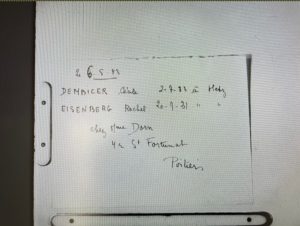
A slip of paper referring to Cécile being placed with Mrs. Dorn.
(Vienne departmental archives)
On May 6, 1943 Cécile Dembicer and Rachel Eisenberg, another girl from Metz who had also been living in Saint Michel de Rivière, were placed with the Dorn family at 6 rue Saint-Fortunat in Poitiers. Cécile was thus reunited with her aunt Rachel, the wife of her uncle Mayer Brunwasser, who was a prisoner of war. She was not, therefore, in a totally unfamiliar environment. The fact that Cécile was not interned in the camp with Simon was no doubt because she was a French citizen, and this appears to have spared her from being deported at that time.
Cécile and Rachel’s did not spend long with the Dorn family, however, since on May 24, 1943, they too were interned at the camp on the Limoges road in Poitiers, where Cécile probably met up with her mother and two younger brothers. Then, on the 26th, they were transferred to Drancy, while Cécile was one of 67 children from the Poitiers camp who were sent to the Lamarck children’s home in Paris. From that day on, she never saw her mother or her brother Jacques again.
Pages from the Poitiers camp register. Contrary to what it says, these children were not in fact transferred to Drancy but to the Lamarck children’s home, on May 26, 1943.
(Vienne departmental archives)
-
Rose and Jacques in the Rothschild hospital. May 29 – July 3, 1943
Anna Tostivint, a 9th grade student at the François Villon junior high school in Saint-Fargeau-Ponthierry in the Seine-et-Marne department of France, is researching the life story of Eugénie Yahya. Through her efforts, we have discovered that after they were sent to Drancy, Rose and her baby were admitted to the Rothschild hospital from May 29 to July 3, 1943.
Extract from the Rothschild hospital admissions register.
(AP-HP – Paris Hospitals Public Welfare – archives)
Photo of the Rothschild hospital at the beginning of the 20th century.
This hospital, founded in 1852, was managed during the war by a team appointed by the German occupying forces. It became a detention center for sick Jews who were to be deported. Many Jewish women gave birth here. Rose was not one of them, but the fact that she was admitted to hospital confirms that, as she had been in Saint-Michel-de-Rivière, she was still in poor health.
Plaque in memory of the Jews who were interned in the Rothschild Hospital.
Anna Tostivint knew that Mrs. Yahya and Mrs. Dembicer were hospitalized on the same dates, and kindly provided us with this hospital photo of Mrs. Yahya and her baby. We then realized that Rose is the woman on the far right. This is the last known photo of Rose and the only existing photo of Jacques. Up until now, no one had a photo of him. This makes it a deeply moving record for his whole family, and for us too. This photo, in which Rose is smiling and holding Jacques, who seems in good health, is all the more poignant given that just a few weeks later, on July 18, 1943, they were deported on Convoy 57 and never came home. Little Jacques was just over six months old.
Photo taken at Rothschild Hospital in June 1943. Rose and Jacques are on the far right.
(Shoah Memorial, Paris)
-
Cécile in the Lamarck center
Cécile arrived at the Lamarck center in Paris, a children’s home run by the UGIF (Union Générale des Israelites de France, or Union of French Jews) on May 27, 1943. The very same day, the manager of the home sent a letter to the supply department of the 18th district of Paris local authority, urgently requesting food ration cards for the 67 children who had arrived and whom he had no way of feeding. He enclosed a list of the children’s names with the letter. The arrivals and departures register shows that Cécile only stayed there for a few days, as she left on June 7, when she was most likely transferred another UGIF home in Louveciennes. It seems that Simon was also sent to Louveciennes, on July 1, 1943. After having been “liberated” from Drancy on June 12, he had been staying at the Lamarck center.
Letter from the manager of the Lamarck center to the head of the supplies department of the 18th district of Paris, dated May 27, 1943. (Shoah Memorial)
Lamarck center register.
(Montmartre Jewish center)
-
Cécile at the Louveciennes children’s home
We have a few records relating to the time Cécile spent at the Séjour-de-Voisins center in Louveciennes towards the end of 1943, and then in a villa on rue de la Paix as of January 1, 1944. Cécile and Simon can be seen in a photo of a group of children taken in Louveciennes, some of whom only spent time there in September 1943. This is the last known photo of the siblings. In addition, the principal of the Leconte de Lisle school unearthed a page from the roll-call register for May 1944, which shows that Cécile was indeed enrolled there, along with some other children from the home. We also know that their first cousins, Joseph and Jacques Tabak, spent the month of August 1943 in Louveciennes. The few weeks they spent together must have been a happy respite for the four children in the midst of all the upheaval they had experienced since 1940.
Photo taken at Louveciennes in September 1943.
(Henry Schumann collection)
Louveciennes elementary school roll-call register for May 1944. The school was closed for a few days to allow students to take the CEP (“Certificate of Studies”) and DEPP (” Diploma of Preparatory Primary Education”, a qualification that was only awarded during the period of the Vichy regime).
(Leconte de Lisle school in Louveciennes)
Both children spent quite a long time at Louveciennes, which provided some stability for them. It came to an abrupt end in July 1944, however.
Cécile’s arrest and deportation (July 1944)
Early in the morning on July 22, 1944, all the children in Louveciennes were suddenly woken up, arrested and taken to Drancy camp. Cécile and Simon were booked in and placed together in room 3 on stairway 6. Since all the children from the various UGIF homes were arrested at around the same time, on the instructions of Aloïs Brunner, who was in charge of Drancy camp, they met up with their cousin Joseph Tabak, who was arrested at the Secrétan home, that same day, and with his brother Jacques, who was arrested at La Varenne, the following day.
Plaque commemorating the roundup of July 22, 1944 outside the “Séjour de Voisins” home in Louveciennes.
Cécile’s internment slip from Drancy camp.
(Shoah Memorial)
Page from the Drancy camp transfer book dated July 22, 1944. (Shoah Memorial)
Photo and plan of Drancy camp.
(Shoah Memorial)
The living conditions in Drancy were very tough, with poor hygiene, insufficient food, various diseases and uncertainty about the future. As the above records show, the camp was guarded by the French military police, who reported to the Police Headquarters at the time. The site was not chosen at random. It was a low-cost housing development which was still under construction in 1941, and its U-shape made it easy to convert into a detention center.
On July 31, 1944, the four cousins were deported to Auschwitz on Convoy 77. They made one final stop near Metz. The train stopped at Novéant, which was the first station in Moselle and thus the first station in Germany at that time. A new driver was assigned and the locomotive was refueled. The train arrived at Auschwitz on August 3. Cécile, her brother and cousins were all sent to the gas chambers. They were officially declared to have died on August 5, 1944.
Photo of the memorial stone near Novéant station, erected in 2016 in memory of the victims of all the deportation convoys that stopped there.


 Français
Français Polski
Polski